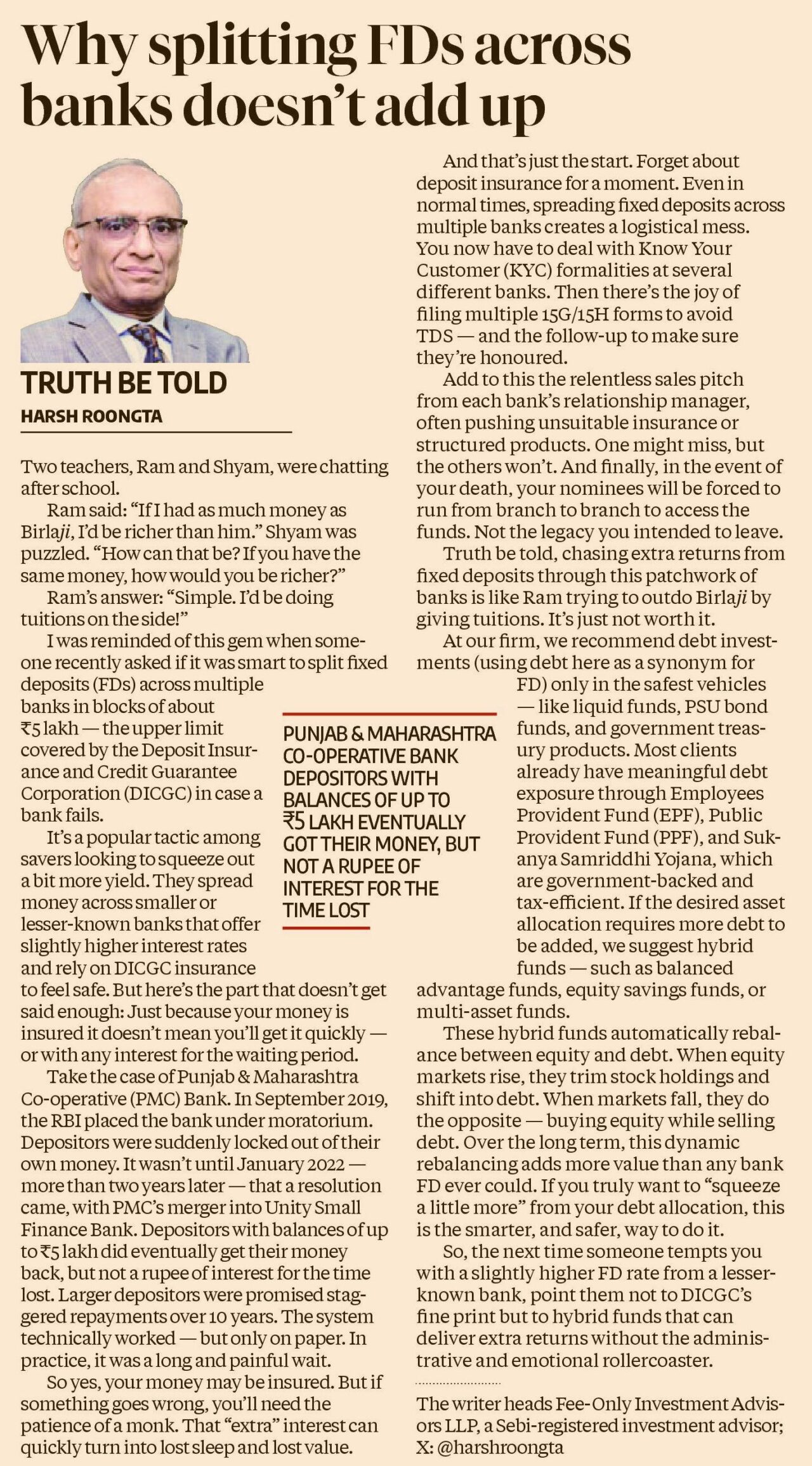
Read the above article in text format below:
Two teachers, Ram and Shyam, were chatting after school.
Ram said: “If I had as much money as Birlaji, I’d be richer than him.”
Shyam was puzzled. “How can that be? If you have the same money, how would you be richer?”
Ram’s answer: “Simple. I’d be doing tuitions on the side!”
I was reminded of this gem when someone recently asked if it was smart to split fixed deposits (FDs) across multiple banks in blocks of about ₹5 lakh — the upper limit covered by the Deposit Insurance and Credit Guarantee Corporation (DICGC) in case a bank fails.
It’s a popular tactic among savers looking to squeeze out a bit more yield. They spread money across smaller or lesser-known banks that offer slightly higher interest rates and rely on DICGC insurance to feel safe. But here’s the part that doesn’t get said enough: Just because your money is insured it doesn’t mean you’ll get it quickly — or with any interest for the waiting period.
Take the case of Punjab & Maharashtra Co-operative (PMC) Bank. In September 2019, the RBI placed the bank under moratorium. Depositors were suddenly locked out of their own money. It wasn’t until January 2022 — more than two years later — that a resolution came, with PMC’s merger into Unity Small Finance Bank. Depositors with balances of up to ₹5 lakh did eventually get their money back, but not a rupee of interest for the time lost. Larger depositors were promised staggered repayments over 10 years. The system technically worked — but only on paper. In practice, it was a long and painful wait.
So yes, your money may be insured. But if something goes wrong, you’ll need the patience of a monk. That “extra” interest can quickly turn into lost sleep and lost value.
And that’s just the start. Forget about deposit insurance for a moment. Even in normal times, spreading fixed deposits across multiple banks creates a logistical mess. You now have to deal with Know Your Customer (KYC) formalities at several different banks. Then there’s the joy of filing multiple 15G/15H forms to avoid TDS — and the follow-up to make sure they’re honoured.
Add to this the relentless sales pitch from each bank’s relationship manager, often pushing unsuitable insurance or structured products. One might miss, but the others won’t. And finally, in the event of your death, your nominees will be forced to run from branch to branch to access the funds. Not the legacy you intended to leave.
Truth be told, chasing extra returns from fixed deposits through this patchwork of banks is like Ram trying to outdo Birlaji by giving tuitions. It’s just not worth it.
At our firm, we recommend debt investments (using debt here as a synonym for FD) only in the safest vehicles — like liquid funds, PSU bond funds, and government treasury products. Most clients already have meaningful debt exposure through Employees Provident Fund (EPF), Public Provident Fund (PPF), and Sukanya Samriddhi Yojana, which are government-backed and tax-efficient. If the desired asset allocation requires more debt to be added, we suggest hybrid funds — such as balanced advantage funds, equity savings funds, or multi-asset funds.
These hybrid funds automatically rebalance between equity and debt. When equity markets rise, they trim stock holdings and shift into debt. When markets fall, they do the opposite — buying equity while selling debt. Over the long term, this dynamic rebalancing adds more value than any bank FD ever could. If you truly want to “squeeze a little more” from your debt allocation, this is the smarter, and safer, way to do it.
So, the next time someone tempts you with a slightly higher FD rate from a lesser-known bank, point them not to DICGC’s fine print but to hybrid funds that can deliver extra returns without the administrative and emotional rollercoaster.
The writer heads Fee-Only Investment Advisors LLP, a Sebi-registered investment advisor; X: @harshroongta
Disclaimer: These are personal views of the writer. They do not necessarily reflect the opinion of www.business-standard.com or the Business Standard newspaper
(A slightly different version of this column first appeared in the Business Standard on June 16, 2025)
